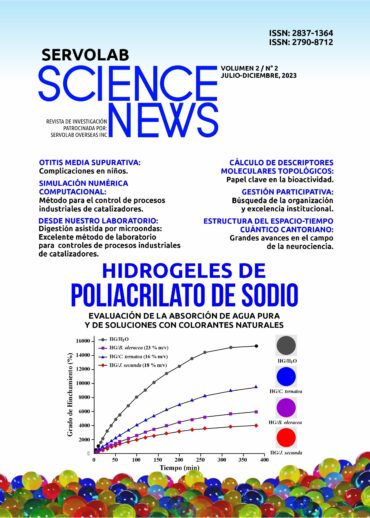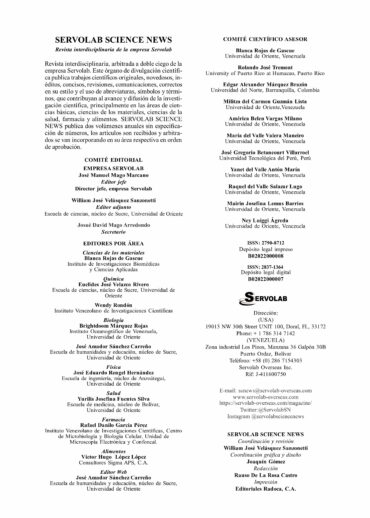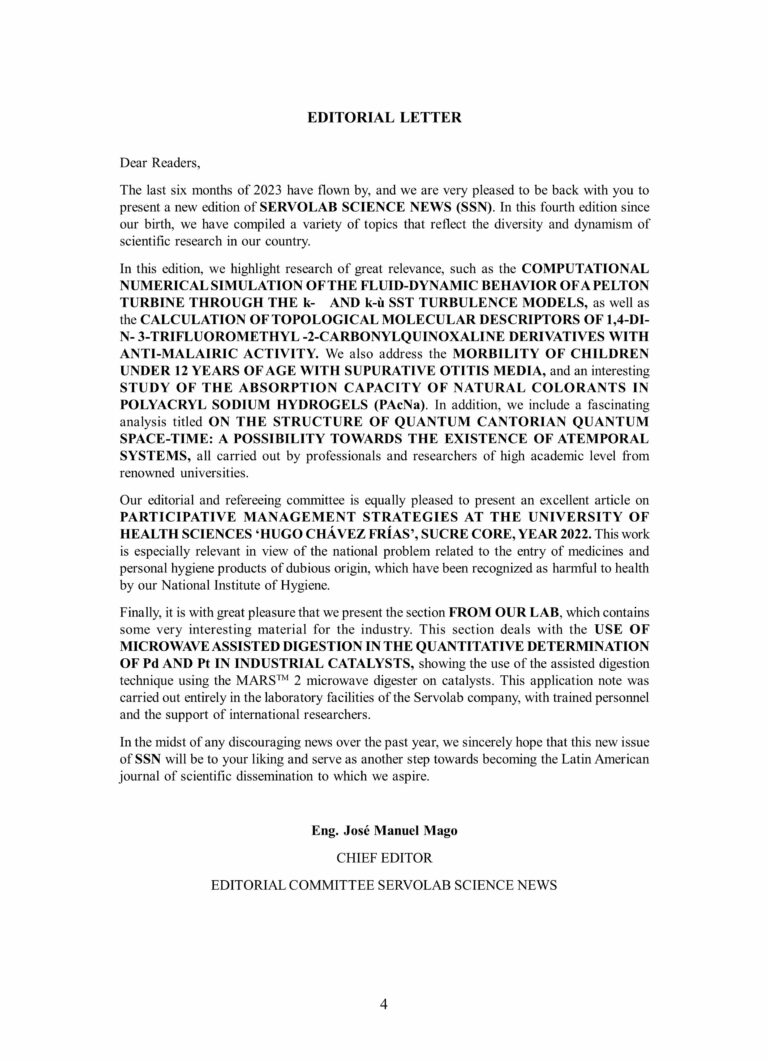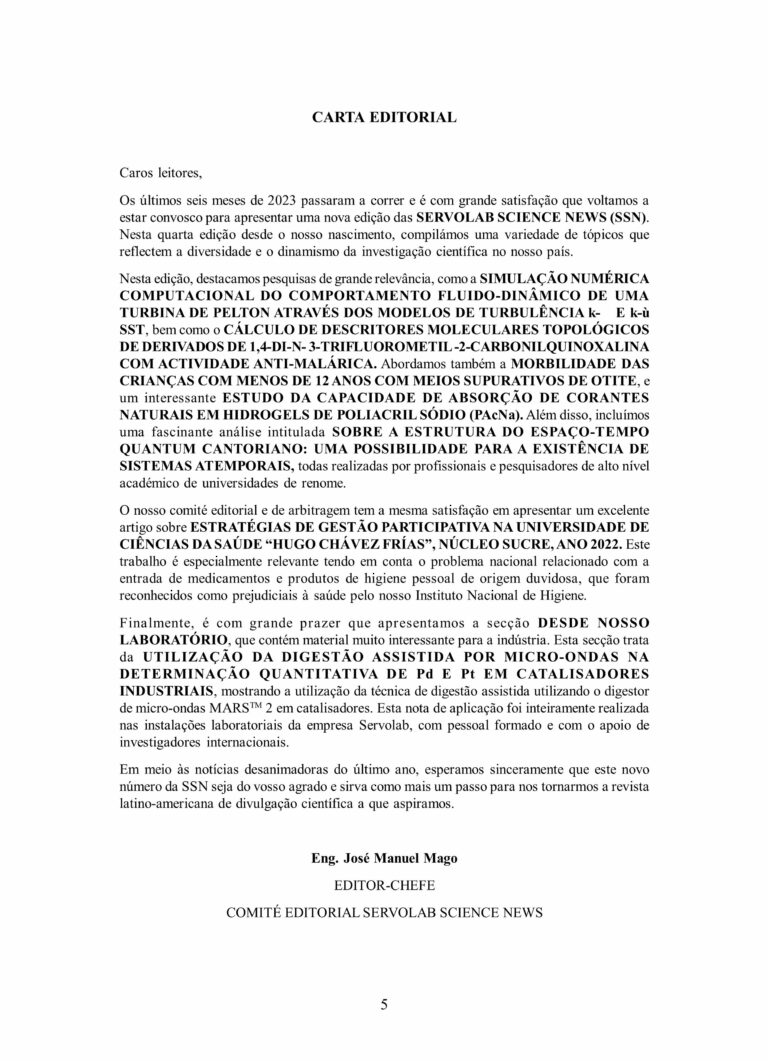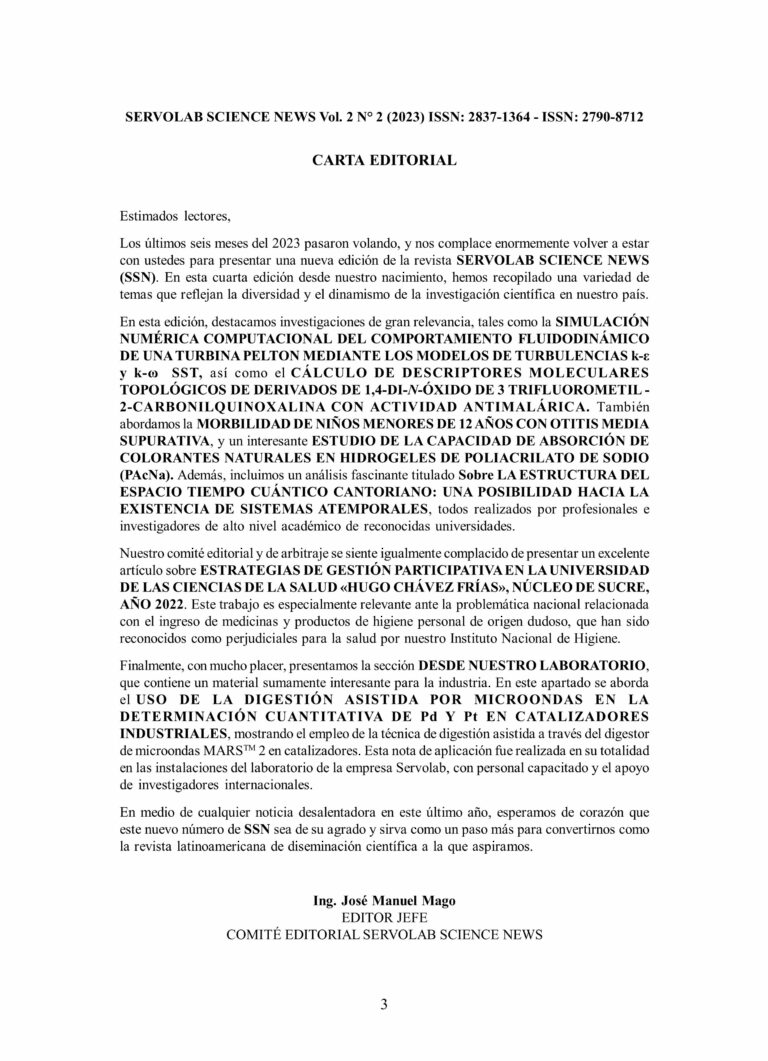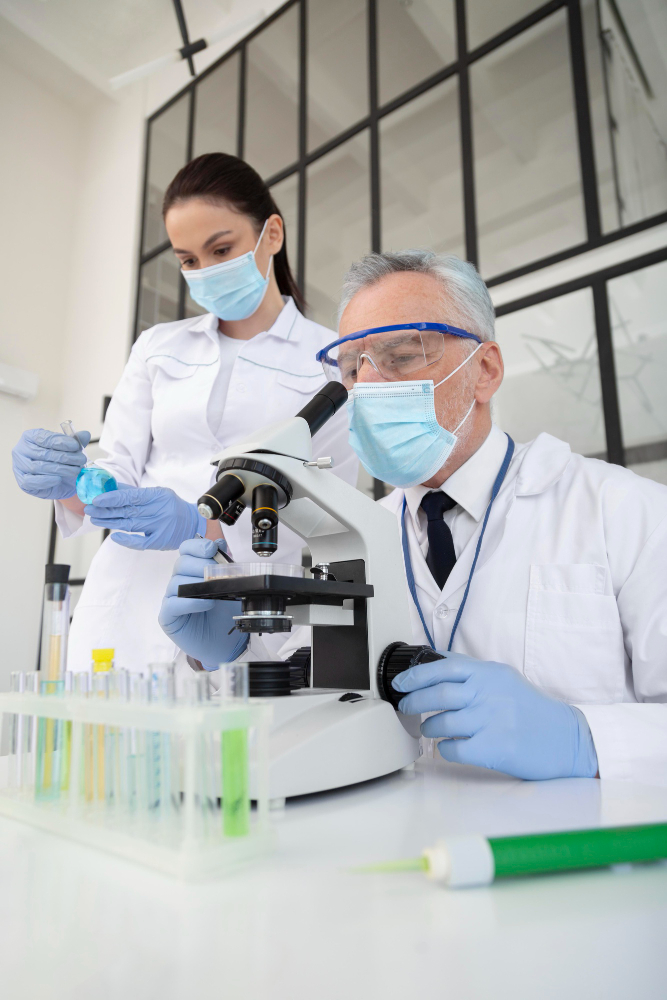VOL.2, N°2 (2023) Julho-Dezembro
- Inicio
- Revistas científicas
- VOL.2, N°2 (2023) Julho-Dezembro
VOL.2, N°2 (2023) Julho-Dezembro
Leia mais sobre o
Publicado: (2023)
USE OF MICROWAVE ASSISTED DIGESTION IN THE QUANTITATIVE DETERMINATION OF PD AND PT IN INDUSTRIAL CATALYSTS
RICHARD HENRÍQUEZ¹, EUCLIDES VELAZCO¹
This report presents the use of the microwave-assisted digestion technique using the MARSTM 2 microwave digester for the subsequent quantitative determination of palladium (Pd) and platinum (Pt) in industrial catalysts. This method shows the advantage of reducing the digestion time of the samples when using microwaves compared to digestion in open containers. Microwave-assisted digestion of real samples of industrial Pd and Pt catalysts was performed. Quantification of the analytes in the solutions of the digestates was performed by flame atomic absorption spectrometry (FAAS) using a NovAA 800D spectrometer. Analysis of the results showed that the standard deviations for the Pd and Pt measurements are 10 and 132 ppm, respectively. However, it can be established that there is good repeatability in both measurements. It is concluded that microwave-assisted digestion turns out to be a good alternative to use in the chemical processing of industrial catalyst samples. While the results obtained for both metals (0.21% Pd and 0.31% Pt) fall within the range of values expected for this type of catalysts.
Key words: catalysts, palladium, platinum, microwave, FAAS
MORBIDITY OF CHILDREN UNDER 12 YEARS OLD WITH SUPURATIVE OTITIS MEDIA
MILGLADYS BELÉN CENTENO-ARENAS¹
Suppurative otitis media is the inflammatory process of the middle ear with the presence of purulent material in the ear canal, secondary to an infection, viral or bacterial. In this research, the morbidity of children under 12 years of age with suppurative otitis media was studied, in the periods 2000-2005 and 2013-2018, in the Otorhinolaryngology service of the Antonio Patricio De Alcala university hospital (HUAPA). For this purpose, the retrospective methodology was used; of type and descriptive level, cross section and field design. The population was 114 individuals, under 12 years of age who attended this service, with a sample equal to the population. Age, sex, type of otitis media (OM), complications and risk factors were taken as variables. It was found that 58.33% (2000-2005) and 61.54% (2013-2018) corresponded to the male sex and in terms of age, 56.52% (2000-2005) and 62.90 % (2013-2018) were in the age group 0 to 2 years. Of the total patients, 91.67% (2000-2005) and 82.05% (2013-2018) presented acute otitis media (AOM). 75.00% (2000-2005) and 72.15% (2013-2018) passed without complications. In relation to risk factors: sex 19.09% (2000-2005) and history of acute otitis media (AOM) and upper respiratory infections (ARI) 24.34% (2013-2018) were the most frequent. All this allows us to conclude that the male sex and the age group from 0 to 2 years were the most prone to this pathology. AOM was the most common type of otitis. In both periods, the majority of patients did not present complications and the most common risk factors were history of AOM, ARI, sex and inadequate breastfeeding.
Key Words: Acute Otitis Media, morbidity, risk factors, complications.
COMPUTATIONAL NUMERICAL SIMULATION OF THE FLUID-DYNAMIC BEHAVIOR OF A PELTON TURBINE USING THE K-Å AND SST TURBULENCE MODELS
YESSICA SALAZAR MARVAL¹, YORDY GONZÁLEZ – RONDÓN¹², JOHNNY JOSÉ MARTÍNEZ³
In this article, the fluid dynamic behavior of the water jet that impacts the ladle of an Armfield FM-32 laboratory Pelton turbine coupled to an Armfield FMSU service unit was evaluated, for different openings of the turbine injector nozzle, using the theory of computational fluid dynamics (computational fluid dynamics, CFD). The methodology consisted of taking the dimensions of the prototype and building the geometry of the Pelton turbine in 3D with CAD software. Likewise, physical models were designed with different percentages of openings (100.00, 85.00, 75.00, 50.00, 25.00 and 15.00%) of the injector nozzle, and the calculation domains were discretized by applying the unstructured meshing technique. The simulations were carried out with transient state CFD software applying two (2) turbulence models, k-ε and k-ε γ k-ω SST. The numerical results showed the convergence curves of turbulence and momentum and mass for each injector opening percentage. The behavior of the pressure and velocity of the water jet, and the pressure contours in the turbine spoon for the different percentages of injector openings with both turbulence models, were also determined. The study demonstrated that numerical simulations of the fluid dynamic behavior of the water jet in the turbine ladles using CFD software generated reliable results in predicting the flow behavior. It was concluded that the turbulence model that best represented the fluid-dynamic behavior of the water jet in the turbine spoons is the k-ω SST.
Keywords: Computational fluid dynamics, turbulence model, hydraulic turbine.
CALCULATION OF TOPOLOGICAL MOLECULAR DESCRIPTORS OF 3-TRIFLUOROMETHYL-2-CARBONYLQUINOXALINE 1,4-DI-N-OXIDE DERIVATIVES WITH ANTIMALARIAL ACTIVITY
EMMANUEL BERNAL-CARABALLO¹,², JESÚS LEZAMA¹*
The quantitative structure-activity relationship (QSAR) is a technique that correlates the chemical structure of compounds with their biological activity. In the context of tropical diseases like malaria, QSAR models are particularly beneficial as they facilitate the development of new effective treatments. A total of 19 compounds derived from 1,4-di-N-oxide-3-trifluoromethyl-2-carbonylquinoxaline with antimalarial activity against Plasmodium falciparum were evaluated through a classical QSAR study. The objective was to establish the structural characteristics that determine antimalarial activity. The minimum energy structures were obtained using Density Functional Theory (DFT), with the correlation functional/basis combination B3LYP/6-31++G(d,p); included in the Gaussian 09® computational package and, from these, the topological descriptors and the 1-octanol/water partition coefficient (log P) were calculated with PerkinElmer Chemoffice 18.1® software. Multiple linear regression analysis was used to establish the correlation between molecular descriptors and antimalarial activity, generating several QSAR models, all of which exhibited good statistical quality (r> 0.8 and Q²> 0.7). This equation indicates that the antimalarial activity of the 1,4-di-N-oxide-3-trifluoromethyl-2-carbonylquinoxaline derivatives is associated with the descriptors sum of degrees of valence, number of rotatable bonds, polar surface area, ovality, total connectivity and log P. This suggests that molecular topology plays a key role in the bioactivity of this group of compounds.
Keywords: QSAR, antimalarial activity, topological descriptors.
STUDY OF THE ABSORPTION CAPACITY OF NATURAL DYES IN SODIUM POLYACRYLATE HYDROGELS (PACNA)
RITA TENÍA¹, CARLOS NÚÑEZ², SHAILILI MORENO³, JOSÉ BENÍTEZ¹, EDGAR CATARÍ⁴, ALEXANDER GARCÍA⁵.
In the present work, the absorption capacity of natural dyes in commercial hydrogels based on sodium polyacrylate (PACNa) was evaluated. The natural dyes were obtained from various natural sources (B. oleracea flower, C. ternatea flower, and the leaf of J. secunda) using conventional solid-liquid extraction methods which showed moderate to high extraction yields. Commercial hydrogels exhibited a high absorption capacity for pure water (> 15000,00%), however, when exposed to the contained solutions of the natural dyes, this absorption capacity was reduced to values of 6001,00% for HG/B. oleracea, 9551,00% for HG/C. ternatea and 4043,00% for HG/J. secunda denoting an effect of restriction of access to the containment sites in the hydrogel. This decreased of absorption capacity can be attributed to the large size of the molecules of certain components of natural dyes, such as saponins, flavonoids, polyphenols, and coumarins
Keywords: hydrogels, sodium polyacrylate, natural dye, swelling, saponins, flavonoids, polyphenols, coumarins
PARTICIPATORY MANAGEMENT STRATEGIES AT THE “HUGO CHÁVEZ FRÍAS” UNIVERSITY OF HEALTH SCIENCES, NÚCLEO SUCRE, YEAR 2022
ERSI VARGAS DÍAZ¹; DAMARIS ZERPA DE MÁRQUEZ¹·²
Participatory management is a strategy to develop quality services and optimize the levels of efficiency and productivity of institutions; for this reason, the objective of this study is to define participatory management strategies at the university of health sciences “Hugo Chávez Frías” (UCS “HCHf”), nucleo Sucre, year 2022. This is a descriptive, cross-sectional study with a population of 58 people and a questionnaire was applied, with prior informed consent. As a result, the majority considered that the development of models of management, training, generation and socialization of knowledge are necessary to respond to the social mandate of the UCS, which is in articulation with all the organizational forms of the national public health system, mainly with the areas of comprehensive community health (ASIC) and with the system of missions and great missions. Internally, the UCS puts into practice the good communication policy, achieving progressive changes with permanent improvements, based on a democratic vision of management, oriented to human talent and characterized by collaborative work between society and government, with linkage mechanisms based on the improvement of academic quality with social relevance, triangulation and participatory analysis of information and the scope of the integration process that predominated was an increase in the number of students. Commitment and responsibility of workers. A strategy of combination of internal and external aspects was defined, such as: management of participatory management processes and strategic alliances with all forms of village organization, respectively.
Key: Strategies, participatory management, articulation, organizational forms, democratic vision.
ON THE STRUCTURE OF CANTORIAN QUANTUM SPACE-TIME: A POSSIBILITY TOWARDS THE EXISTENCE OF TIMELESS SYSTEMS
MARÍA T. MALAVÉ-RAMÍREZ
An analysis is carried out on the nature of time from a philosophical point of view. The concept of fractal time and cantorian quantum space-time is studied, proposing various alternatives for their use in numerical and scientific experiments, specifically; those that are carried out at a microscopic level. Finally, the conjecture is raised about the existence of timeless systems, which are systems that, as their name indicates, lack a temporal dimension. This finding would allow great advances in the field of neuroscience.
Keywords. Cantor sets, fractal time, space-time, philosophy, physics, cognitive processes.

